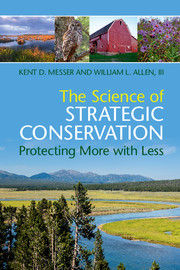Book contents
- The Science of Strategic Conservation
- The Science of Strategic Conservation
- Copyright page
- Dedication
- Contents
- Foreword
- Acknowledgments
- 1 Strategic Conservation Matters
- 2 A $100 Bottle of Wine and a Hammer: Core Principles of Strategic Conservation
- 3 From Great Ideas to Costly Habits
- 4 Avoiding Budget Sponges and Other Lessons from Conservation Failures
- 5 Moving from Mission to Vision to Criteria
- 6 Transforming Criteria into Conservation Benefits
- 7 Enhancing the Evaluation of Choices
- 8 Getting the Best Bang for Your Buck
- 9 Harnessing the Power of Markets and Behavioral Nudges
- 10 Putting It All Together: A Short Story
- 11 Do It! Exercises Using the Optimization Decision Support Tool
- 12 Do It! Exercises Using the Logic Scoring of Preference Method
- A Mathematical Foundations of the Logic Scoring of Preference Method
- References
- Index
- References
References
Published online by Cambridge University Press: 03 May 2018
- The Science of Strategic Conservation
- The Science of Strategic Conservation
- Copyright page
- Dedication
- Contents
- Foreword
- Acknowledgments
- 1 Strategic Conservation Matters
- 2 A $100 Bottle of Wine and a Hammer: Core Principles of Strategic Conservation
- 3 From Great Ideas to Costly Habits
- 4 Avoiding Budget Sponges and Other Lessons from Conservation Failures
- 5 Moving from Mission to Vision to Criteria
- 6 Transforming Criteria into Conservation Benefits
- 7 Enhancing the Evaluation of Choices
- 8 Getting the Best Bang for Your Buck
- 9 Harnessing the Power of Markets and Behavioral Nudges
- 10 Putting It All Together: A Short Story
- 11 Do It! Exercises Using the Optimization Decision Support Tool
- 12 Do It! Exercises Using the Logic Scoring of Preference Method
- A Mathematical Foundations of the Logic Scoring of Preference Method
- References
- Index
- References
- Type
- Chapter
- Information
- The Science of Strategic ConservationProtecting More with Less, pp. 301 - 325Publisher: Cambridge University PressPrint publication year: 2018



